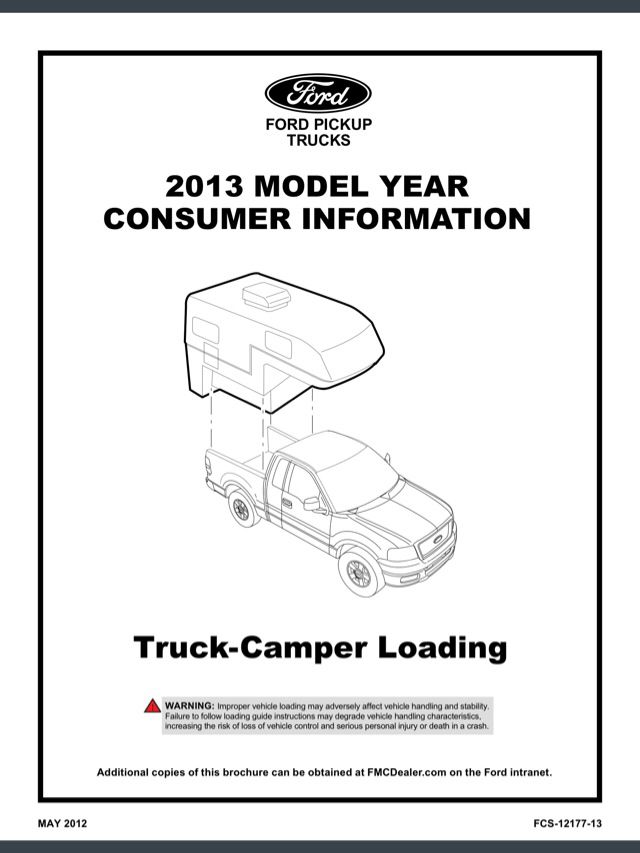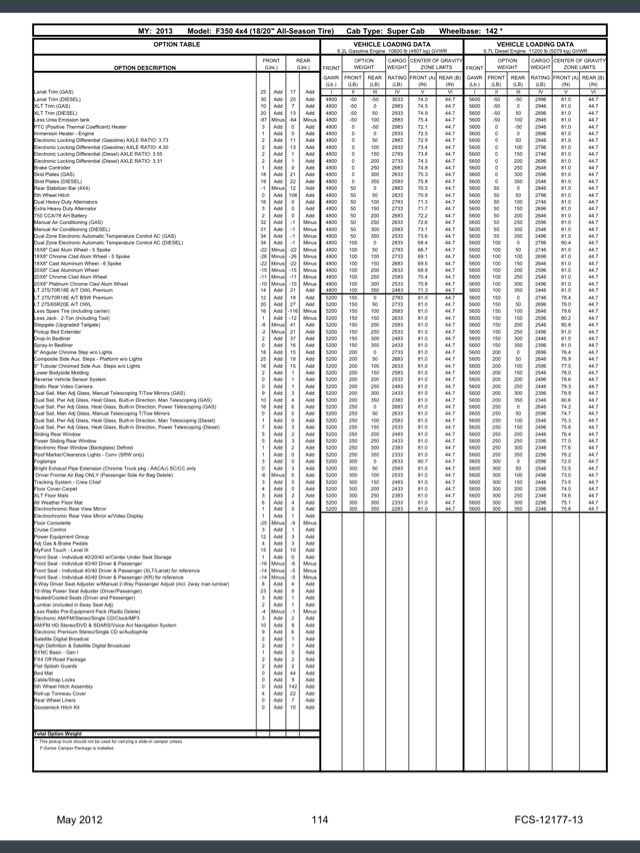- Good Sam Community
- Groups
- Travel Trailer Group
- Forum
- Startling insurance info
- Subscribe to RSS Feed
- Mark Topic as New
- Mark Topic as Read
- Float this Topic for Current User
- Bookmark
- Subscribe
- Mute
- Printer Friendly Page
Startling insurance info
- Mark as New
- Bookmark
- Subscribe
- Mute
- Subscribe to RSS Feed
- Permalink
- Report Inappropriate Content
Jun-19-2014 06:18 AM
This is a confusing issue and each insurance company may have different stipulations based upon individual coverage. There is a reason why airplanes are not flown out of c of g and over gross weight. I only post this to bring to your attention the need to ensure that you will be covered under these circumstances. Hope this helps.
- Labels:
-
Truck Campers
- Mark as New
- Bookmark
- Subscribe
- Mute
- Subscribe to RSS Feed
- Permalink
- Report Inappropriate Content
Jul-03-2014 01:37 PM
ghostrider421 wrote:
. Our Unimog doesn't have one, as it was built in Germany.
My Unimog was also built in Germany but it has a door placard with front and rear axle capacity and GVWR.
Charlie
- Mark as New
- Bookmark
- Subscribe
- Mute
- Subscribe to RSS Feed
- Permalink
- Report Inappropriate Content
Jul-03-2014 10:47 AM
Guyana - 2013-2019 Dodge 1500, Lance camper - SOLD
Brasil - 2019 > 12m work boat conversion - leased out
Panana - 1976 > 16m Skookum ketch
- Mark as New
- Bookmark
- Subscribe
- Mute
- Subscribe to RSS Feed
- Permalink
- Report Inappropriate Content
Jun-23-2014 09:10 AM
and as explained in other threads, it's the GAWR and the LICENSED GVWR that the law is concerned about..
- Mark as New
- Bookmark
- Subscribe
- Mute
- Subscribe to RSS Feed
- Permalink
- Report Inappropriate Content
Jun-21-2014 06:47 PM
ghostrider421 wrote:Jfet wrote:
With a sticker GVWR of 19,500 that gives us about 10,000 pounds for our camper and gear.
Not GVWR, but GCWR
No Jfet's truck is rated for 19,500 GVWR. Look up his past posts, he is custom building a truck camper for his COE flatbed class 5 truck
I try to always leave doubt to my ignorance rather than prove it
2021 Winnebago View
- Mark as New
- Bookmark
- Subscribe
- Mute
- Subscribe to RSS Feed
- Permalink
- Report Inappropriate Content
Jun-21-2014 06:02 PM
Jfet wrote:
With a sticker GVWR of 19,500 that gives us about 10,000 pounds for our camper and gear.
Not GVWR, but GCWR
Guyana - 2013-2019 Dodge 1500, Lance camper - SOLD
Brasil - 2019 > 12m work boat conversion - leased out
Panana - 1976 > 16m Skookum ketch
- Mark as New
- Bookmark
- Subscribe
- Mute
- Subscribe to RSS Feed
- Permalink
- Report Inappropriate Content
Jun-21-2014 05:59 PM
nipster wrote:
Easy... if you are ever in an accident, dump your water load, that would certainly help
Don't worry that along with something else will self-dump:E
Guyana - 2013-2019 Dodge 1500, Lance camper - SOLD
Brasil - 2019 > 12m work boat conversion - leased out
Panana - 1976 > 16m Skookum ketch
- Mark as New
- Bookmark
- Subscribe
- Mute
- Subscribe to RSS Feed
- Permalink
- Report Inappropriate Content
Jun-21-2014 09:37 AM
It also reinforces the fact you do not run the tires at the maximum psi listed on the tire, for all loads as many posters have suggested.
2004.5 Ram SLT LB 3500 DRW Quad Cab 4x4
1988 Bigfoot (C11.5) TC (1900# w/standard equip. per decal), 130 watts solar, 100 AH AGM, Polar Cub A/C, EU2000i Honda
Toad: 91 Zuke
- Mark as New
- Bookmark
- Subscribe
- Mute
- Subscribe to RSS Feed
- Permalink
- Report Inappropriate Content
Jun-21-2014 09:14 AM
Reddog1 wrote:
I also see it states "with" tire size given and psi. If you have the original tires, would you look and see the load capacity on the sidewall is?
What am I missing?
In reference to the inflation number for the tires on the sticker.

What Ford is saying is at the inflation numbers on the sticker the tires are capable of supporting the maximum GVWR of the truck ( loaded up to 6230 pounds) with what ever safety margin Ford deems acceptable as well as providing a balance between ride, handling, and fuel economy that they deem appropriate.
Adding up the tire rating on my truck is pretty meaningless. For example, the rears are derated to 2910 (because of the DRW configuration). Four of them gives 11,640 pounds. Add the fronts at 3195 each and you get a total of more than 18,000 pounds capacity. Clearly other components are limiting the GVWR of the truck. If you inflate the tires to the maximum 80 psi that is on the sidewall you are inflating beyond the needed carrying capacity of the truck. The 65 psi Ford recommends for the rear tires supplies the necessary carrying capacity for the trucks GVWR but balances out the other considerations.
- Mark as New
- Bookmark
- Subscribe
- Mute
- Subscribe to RSS Feed
- Permalink
- Report Inappropriate Content
Jun-21-2014 08:57 AM
2004.5 Ram SLT LB 3500 DRW Quad Cab 4x4
1988 Bigfoot (C11.5) TC (1900# w/standard equip. per decal), 130 watts solar, 100 AH AGM, Polar Cub A/C, EU2000i Honda
Toad: 91 Zuke
- Mark as New
- Bookmark
- Subscribe
- Mute
- Subscribe to RSS Feed
- Permalink
- Report Inappropriate Content
Jun-21-2014 08:49 AM
Bumpyroad wrote:I think nipster was referring to his TC. :Bnipster wrote:
Easy... if you are ever in an accident, dump your water load, that would certainly help
when I am in an accident, I also dump my solids.
bumpy
2004.5 Ram SLT LB 3500 DRW Quad Cab 4x4
1988 Bigfoot (C11.5) TC (1900# w/standard equip. per decal), 130 watts solar, 100 AH AGM, Polar Cub A/C, EU2000i Honda
Toad: 91 Zuke
- Mark as New
- Bookmark
- Subscribe
- Mute
- Subscribe to RSS Feed
- Permalink
- Report Inappropriate Content
Jun-21-2014 08:45 AM
Jfet wrote:
You don't have to guess. You can drive over truck scales and get an official weight of your truck for around $10.
I did this and found our truck was 8700 pounds. With a sticker GVWR of 19,500 that gives us about 10,000 pounds for our camper and gear.
10K of payload capacity? What kind of truck is this?
2013 Lance 825
Rancho 9000XLs Firestone Bags
2002 Jeep TJ Sahara Auto 6cyl
- Mark as New
- Bookmark
- Subscribe
- Mute
- Subscribe to RSS Feed
- Permalink
- Report Inappropriate Content
Jun-21-2014 08:33 AM
Wo.ody wrote:
Anutami's sticker says the GVWR is 9900 pounds.
Regarding the sticker in brholt's post on 6-21-14 12:58 am, which model Ford has a 14,000 pound GVWR?
The 2013 ford DRW models were the first to have a 14,000 GVWR. I believe the 2012's were a maximum of 13,300 pounds.
- Mark as New
- Bookmark
- Subscribe
- Mute
- Subscribe to RSS Feed
- Permalink
- Report Inappropriate Content
Jun-21-2014 08:30 AM
Reddog1 wrote:
Maybe I don't understand what you are saying, but I do not see anything that states the weight of your truck. What I read is the most it can weigh (GVWR) is 14000 pounds. The second decal repeats the tire data of the first, and says the combined weight that should never exceed (6229). Neither number says the existing weight of anything that I can see.
Actually I find the two decals a little confusing. Gross Vehicle Weight Rating (GVWR) is the maximum allowable weight of a fully loaded vehicle, including the weight of the vehicle, options, passengers, cargo, gas, oil, etc.. The first decal says it is 14000 pounds. The second decal says combined weight of occupants and cargo should not exceed 6229 pounds. The numbers suggest the truck weighs no more than 7770 pounds, but without knowing how it is equipped they still do not know. My bet is if you took it to the scales it would not weigh 7700 pounds.
I also see it states "with" tire size given and psi. If you have the original tires, would you look and see the load capacity on the sidewall is?
What am I missing?
The difference between the GVWR and the max occupant load is pretty much the weight of the truck as Ford manufactured it with the options it came with (Though I believe the maximum occupant load is with a full load of fuel and fluids) Weighing your own truck will give somewhat different numbers depending on your fuel state and how much stuff you have added to your truck (bed liners, mud flaps, tools, yourself 🙂 and what not).
Before ordering my truck the dealer gave me a Ford PDF available to dealers:

This document (136 pages) lists every Ford pickup model, all of the options available, and the weight of the option as well as the distribution of weight to the front and rear axles. For example (probably not readable but you get the idea):

My understanding is this data allows Ford to individualize both the carrying capacity sticker and the truck camper inset for the particular configuration ordered.
- Mark as New
- Bookmark
- Subscribe
- Mute
- Subscribe to RSS Feed
- Permalink
- Report Inappropriate Content
Jun-21-2014 07:24 AM
Wo.ody wrote:Reddog1 wrote:
Maybe I don't understand what you are saying, but I do not see anything that states the weight of your truck. What I read is the most it can weigh (GVWR) is 14000 pounds. The second decal repeats the tire data of the first, and says the combined weight that should never exceed (6229). Neither number says the existing weight of anything that I can see.
Actually I find the two decals a little confusing. Gross Vehicle Weight Rating (GVWR) is the maximum allowable weight of a fully loaded vehicle, including the weight of the vehicle, options, passengers, cargo, gas, oil, etc.. The first decal says it is 14000 pounds. The second decal says combined weight of occupants and cargo should not exceed 6229 pounds. The numbers suggest the truck weighs no more than 7770 pounds, but without knowing how it is equipped they still do not know. My bet is if you took it to the scales it would not weigh 7700 pounds.
I also see it states "with" tire size given and psi. If you have the original tires, would you look and see the load capacity on the sidewall is?
What am I missing?
Anutami's sticker says the GVWR is 9900 pounds.
Regarding the sticker in brholt's post on 6-21-14 12:58 am, which model Ford has a 14,000 pound GVWR?
A new F350 dually, I have a 2013 Ram dually and it also has a GVWR of 14,000#
I try to always leave doubt to my ignorance rather than prove it
2021 Winnebago View





